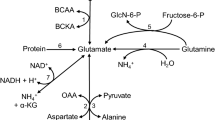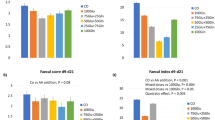Abstract
Dietary intake of glutamate by postweaning pigs is markedly reduced due to low feed consumption. This study was conducted to determine the safety and efficacy of dietary supplementation with monosodium glutamate (MSG) in postweaning pigs. Piglets were weaned at 21 days of age to a corn and soybean meal-based diet supplemented with 0, 0.5, 1, 2, and 4 % MSG (n = 25/group). MSG was added to the basal diet at the expense of cornstarch. At 42 days of age (21 days after weaning), blood samples (10 mL) were obtained from the jugular vein of 25 pigs/group at 1 and 4 h after feeding for hematological and clinical chemistry tests; thereafter, pigs (n = 6/group) were euthanized to obtain tissues for histopathological examinations. Feed intake was not affected by dietary supplementation with 0–2 % MSG and was 15 % lower in pigs supplemented with 4 % MSG compared with the 0 % MSG group. Compared with the control, dietary supplementation with 1, 2 and 4 % MSG dose-dependently increased plasma concentrations of glutamate, glutamine, and other amino acids (including lysine, methionine, phenylalanine and leucine), daily weight gain, and feed efficiency in postweaning pigs. At day 7 postweaning, dietary supplementation with 1–4 % MSG also increased jejunal villus height, DNA content, and antioxidative capacity. The MSG supplementation dose-dependently reduced the incidence of diarrhea during the first week after weaning. All variables in standard hematology and clinical chemistry tests, as well as gross and microscopic structures, did not differ among the five groups of pigs. These results indicate that dietary supplementation with up to 4 % MSG is safe and improves growth performance in postweaning pigs.
Similar content being viewed by others
References
Bergen WG (1974) Protein synthesis in animal models. J Anim Sci 38:1079–1091
Bertolo RF, Burrin DG (2008) Comparative aspects of tissue Glutamine and proline metabolism. J Nutr 138:2032S–2039S
Blachier F, Boutry C, Bos C, Tome D (2009) Metabolism and functions of l-glutamate in the epithelial cells of the small and large intestines. Am J Clin Nutr 90:814S–821S
Boutry C, Matsumoto H, Airinei G, Benamouzig R, Tomé D, Blachier F, Bos C (2011) Monosodium glutamate raises antral distension and plasma amino acid after a standard meal in humans. Am J Physiol 300:G137–G145
Brosnan JT, Brosnan ME (2012) Glutamate: a truly functional amino acid. Amino Acids. doi:10.1007/s00726-012-1280-4
Burrin DG, Stoll B (2009) Metabolic fate and function of dietary glutamate in the gut. Am J Clin Nutr 90:850S–856S
Chen LX, Yin YL, Jobgen WS, Jobgen SC, Knabe DA, Hu WX, Wu G (2007) In vitro oxidation of essential amino acids by intestinal mucosal cells of growing pigs. Livest Sci 109:19–23
Chen LX, Li P, Wang JJ, Li XL, Gao HJ, Yin YL, Hou YQ, Wu G (2009) Catabolism of nutritionally essential amino acids in developing porcine enterocytes. Amino Acids 37:143–152
Curi R, Lagranha CJ, Doi SQ, Sellitti DF, Procopio J, Pithon-Curi TC, Corless M, Newsholme P (2005) Molecular mechanisms of glutamine action. J Cell Physiol 204:392–401
Curthoys NP, Watford M (1995) Regulation of glutaminase activity and glutamine metabolism. Annu Rev Nutr 15:133–159
Dai ZL, Zhang J, Wu G, Zhu WY (2010) Utilization of amino acids by bacteria from the pig small intestine. Amino Acids 39:1201–1215
Dai ZL, Wu G, Zhu WY (2011) Amino acid metabolism in intestinal bacteria: links between gut ecology and host health. Front Biosci 16:1768–1786
Dai ZL, Li XL, Xi PB, Zhang J, Wu G, Zhu WY (2012a) Metabolism of select amino acids in bacteria from the pig small intestine. Amino Acids 42:1597–1608
Dai ZL, Li XL, Xi PB, Zhang J, Wu G, Zhu WY (2012b) Regulatory role for l-arginine in the utilization of amino acids by pig small-intestinal bacteria. Amino Acids 43:233–244
Dai ZL, Li XL, Xi PB, Zhang J, Wu G, Zhu WY (2012c) l-Glutamine regulates amino acid utilization by intestinal bacteria. Amino Acids. doi:10.1007/s00726-012-1264-4
Dugan MER, Knabe DA, Wu G (1994) Glutamine and glucose metabolism in intraepithelial lymphocytes from pre and post-weaning pigs. Comp Biochem Physiol 109B:675–681
Flynn NE, Wu G (1996) An important role for endogenous synthesis of arginine in maintaining arginine homeostasis in neonatal pigs. Am J Physiol 271:R1149–R1155
Haynes TE, Li P, Li XL, Shimotori K, Sato H, Flynn NE, Wang JJ, Knabe DA, Wu G (2009) L-Glutamine or L-alanyl-L-glutamine prevents oxidant- or endotoxin-induced death of neonatal enterocytes. Amino Acids 37:131–142
Horvath K, Jami M, Hill ID, Papadimitriou JC, Magder LS, Chanasongcram S (1994) Isocaloric glutamine-free diet and the morphology and function of rat small intestine. J Parent Enter Nutr 20:128–134
Iwatsuki K, Torii K (2012) Peripheral chemosensing system for tastants and nutrients. Curr Opin Endocrinol Diabetes Obes 19:19–25
Janeczko M, Stoll B, Chang X, Guan X, Burrin DG (2007) Extensive gut metabolism limits the intestinal absorption of excessive supplemental dietary glutamate loads in infant pigs. J Nutr 137:1284–1390
Jobgen WJ, Meininger CJ, Jobgen SC, Li P, Lee MJ, Smith SB, Spencer TE, Fried SK, Wu G (2009) Dietary l-arginine supplementation reduces white-fat gain and enhances skeletal muscle and brown fat masses in diet-induced obese rats. J Nutr 139:230–237
Kim SW, Wu G (2004) Dietary arginine supplementation enhances the growth of milk-fed young pigs. J Nutr 134:625–630
Kirchgessner AL (2001) Glutamate in the enteric nervous system. Curr Opin Pharmacol 1:591–596
Klein RM, McKenzie JC (1983) The role of cell renewal in the ontogeny of the intestine. I. Cell proliferation patterns in adult, fetal, and neonatal intestine. J Pediatr Gastroenterol Nutr 2:10–43
Kondoh T, Torii K (2008) MSG intake suppresses weight gain, fat deposition, and plasma leptin levels in male Sprague-Dawley rats. Physiol Behav 95:135–144
Lalles JP, Bosi P, Smidt H, Stokes CR (2007) Weaning—a challenge to gut physiologists. Livest Sci 108:82–93
Li P, Kim SW, Li XL, Datta S, Pond WG, Wu G (2009) Dietary supplementation with cholesterol and docosahexaenoic acid affects concentrations of amino acids in tissues of young pigs. Amino Acids 37:709–716
Li XL, Rezaei R, Li P, Wu G (2011) Composition of amino acids in feed ingredients for animal diets. Amino Acids 40:1159–1168
Liu T, Peng J, Xiong Y, Zhou S, Cheng X (2002) Effects of dietary glutamine and glutamate supplementation on small intestinal structure, active absorption and DNA, RNA concentrations in skeletal muscle tissue of weaned piglets during d 28 to 42 of age. Asian-Aust J Anim Sci 15:238–242
Mahan DC, Wiseman TD, Weaver E, Russell L (1999) Effect of supplemental sodium chloride and hydrochloric acid added to initial starter diets containing spray-dried blood plasma and lactose on resulting performance and nitrogen digestibility of 3-week-old weaned pigs. J Anim Sci 77:3016–3021
Mateo RD, Wu G, Moon HK, Carroll JA, Kim SW (2008) Effects of dietary arginine supplementation during gestation and lactation on the performance of lactating primiparous sows and nursing piglets. J Anim Sci 86:827–835
Murphy JM, Murch SJ, Ball RO (1996) Proline is synthesized from glutamate during intragastric infusion but not during intravenous infusion in neonatal pigs. J Nutr 126:878–886
Ou DY, Li DF, Cao YH, Li XL, Yin JD, Qiao SY, Wu G (2007) Dietary supplementation with zinc oxide decreases expression of the stem cell factor in the SI of weanling pigs. J Nutr Biochem 18:820–826
Plusk JR, Hampson DJ, Williams IH (1997) Factors influencing the structure and function of the small intestine in the weaned pig: a review. Livest Prod Sci 51:215–236
Prasad AS, DuMouchelle E, Koniuch D, Oberleas D (1972) A simple fluorometric method for the determination of RNA and DNA in tissues. J Lab Clin Med 80:598–601
Rhoads JM, Wu G (2009) Glutamine, arginine, and leucine signaling in the intestine. Amino Acids 37:111–122
San Gabriel A, Uneyama H (2012) Amino acid sensing in the gastrointestinal tract. Amino Acids. doi:10.1007/s00726-012-1371-2
San Gabriel A, Nakamura E, Uneyama H, Torii K (2009) Taste, visceral information and exocrine reflexes with glutamate through umami receptors. J Med Invest 56(Suppl):209–217
Satterfield MC, Dunlap KA, Keisler DH, Bazer FW, Wu G (2012) Arginine nutrition and fetal brown adipose tissue development in nutrient-restricted sheep. Amino Acids. doi:10.1007/s00726-011-1168-8
Smriga M, Torii K (2000) Release of hypothalamic norepinephrine during MSG intake in rats fed normal and nonprotein diet. Physiol Behav 70:413–415
Smriga M, Murakami H, Mori M, Torii K (2000) Use of thermal photography to explore the age-dependent effect of monosodium glutamate, NaCl and glucose on brown adipose tissue thermogenesis. Physiol Behav 71:403–407
Somekawa S, Hayashi N, Niijima A, Uneyama H, Torii K (2012) Dietary free glutamate prevents diarrhoea during intra-gastric tube feeding in a rat model. Br J Nutr 107:20–23
Stoll B, Burrin DG, Henry J, Yu H, Jahoor F, Reeds PJ (1999) Substrate oxidation by the portal drained viscera of fed pigs. Am J Physiol 277:E168–E175
Strous GJ, Dekker J (1992) Mucin-type glycoproteins. Crit Rev Biochem Mol Biol 27:57–92
Wang JJ, Chen LX, Li P, Li XL, Zhou HJ, Wang FL, Li DF, Yin YL, Wu G (2008) Gene expression is altered in piglet small intestine by weaning and dietary glutamine supplementation. J Nutr 138:1025–1032
Wei JW, Carroll RJ, Harden KK, Wu G (2012) Comparisons of treatment means when factors do not interact in two-factorial studies. Amino Acids 42:2031–2035
Wu G (1998) Intestinal mucosal amino acid catabolism. J Nutr 128:1249–1252
Wu G (2009) Amino acids: metabolism, functions, and nutrition. Amino Acids 37:1–17
Wu G (2010) Functional amino acids in growth, reproduction and health. Adv Nutr 1:31–37
Wu G, Knabe DA (1995) Arginine synthesis in enterocytes of neonatal pigs. Am J Physiol 269:R621–R629
Wu G, Morris SM (1998) Arginine metabolism: nitric oxide and beyond. Biochem J 336:1–17
Wu G, Borbolla AG, Knabe DA (1994) The uptake of glutamine and release of arginine, citrulline and proline by the small intestine of developing pigs. J Nutr 124:2437–2444
Wu G, Knabe DA, Yan W, Flynn NE (1995) Glutamine and glucose metabolism in enterocytes of the neonatal pig. Am J Physiol 268:R334–R342
Wu G, Meier SA, Knabe DA (1996) Dietary Glutamine supplementation prevents jejunal atrophy in weaned pigs. J Nutr 126:2578–2584
Wu G, Davis PK, Flynn NE, Knabe DA, Davidson JT (1997) Endogenous synthesis of arginine plays an important role in maintaining arginine homeostasis in postweaning growing pigs. J Nutr 127:2342–2349
Wu G, Fang YZ, Yang S, Lupton JR, Turner ND (2004) Glutathione metabolism and its implications for health. J Nutr 134:489–492
Wu G, Bazer FW, Johnson GA, Knabe DA, Burghardt RC, Spencer TE, Li XL, Wang JJ (2011) Important roles for l-glutamine in swine nutrition and production. J Anim Sci 89:2017–2030
Yao K, Yin YL, Li XL, Xi PB, Wang JJ, Lei J, Hou YQ, Wu G (2012) Alpha-ketoglutarate inhibits glutamine degradation and enhances protein synthesis in intestinal porcine epithelial cells. Amino Acids 42:2491–2500
Zimmerman DR (1975) Glutamic acid and tryptophan additions to a low-protein pig starter. J Anim Sci 40:871–874
Acknowledgments
This research was supported by a grant from the International Glutamate Technical Committee (Brussels, Belgium). We thank our graduate students and technicians for assistance in this work.
Conflict of interest
The authors declare that they have no conflict of interest.
Author information
Authors and Affiliations
Corresponding author
Rights and permissions
About this article
Cite this article
Rezaei, R., Knabe, D.A., Tekwe, C.D. et al. Dietary supplementation with monosodium glutamate is safe and improves growth performance in postweaning pigs. Amino Acids 44, 911–923 (2013). https://doi.org/10.1007/s00726-012-1420-x
Received:
Accepted:
Published:
Issue Date:
DOI: https://doi.org/10.1007/s00726-012-1420-x




